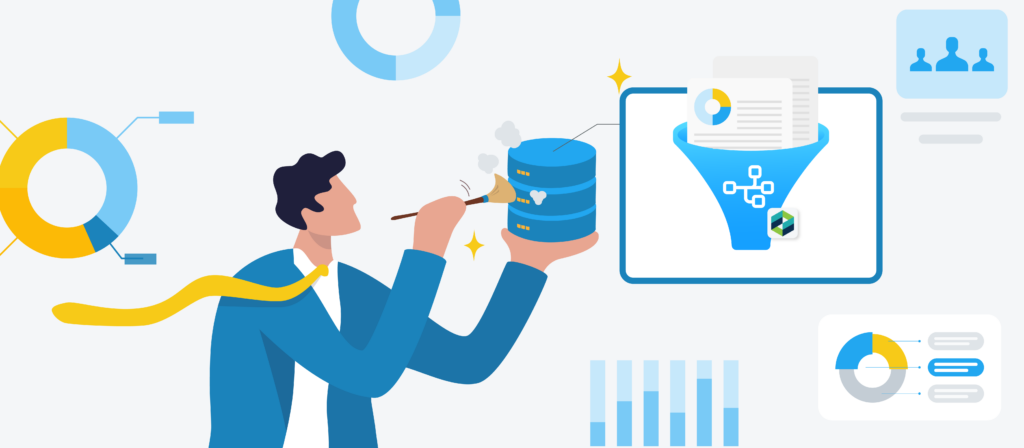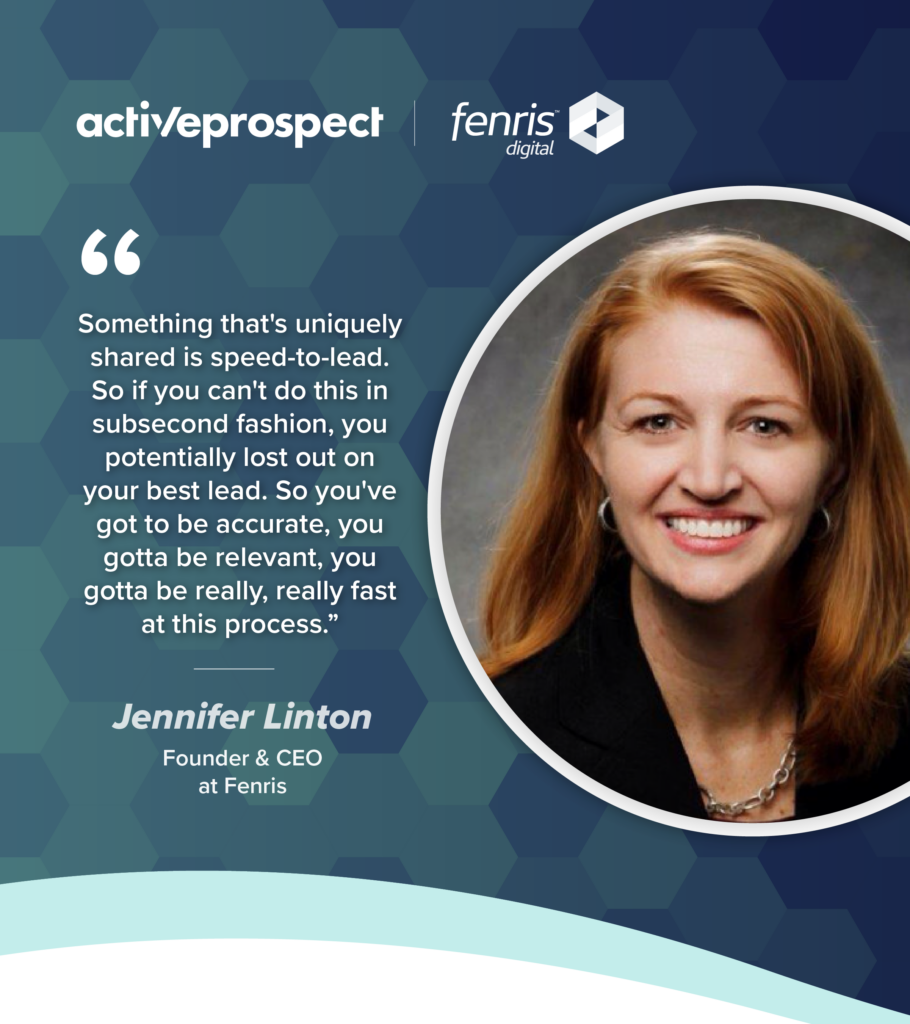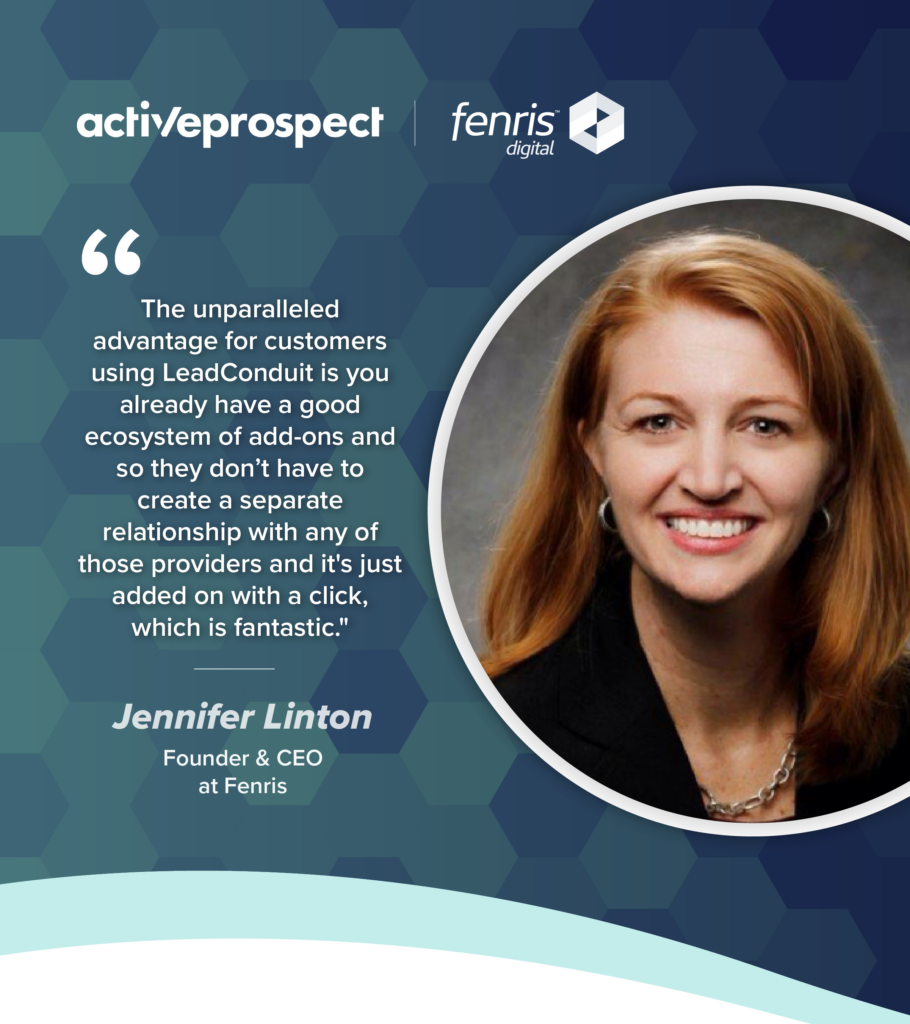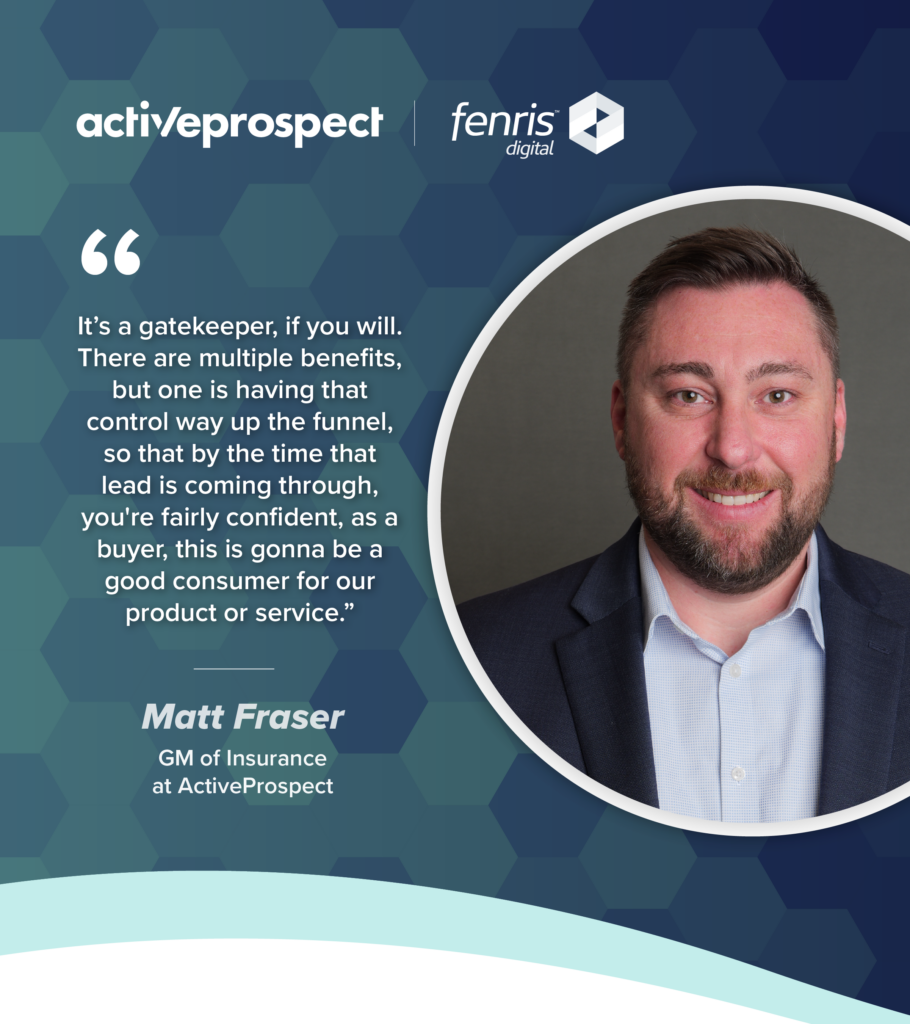From click to conversion: The role of data enrichment

In our recent webinar, “The power of data: How data enhances lead generation and buyer performance,” Matt Fraser, our GM of Insurance, had the opportunity to engage in a stimulating discussion with Jennifer Linton, the CEO and founder of Fenris. The primary focus of their discussion was the role of data enrichment in enhancing lead generation, buyer performance, and conversion rates.
In their conversation, they also explored an essential tool in the market, ActiveProspect’s LeadConduit, and how it enhances lead distribution, filtering, and real-time decision making.
Key takeaways
Here are the main takeaways from our Insurance-specific webinar, “The power of data: How data enhances lead generation and buyer performance:”
- Data enrichment can significantly improve lead management and customer acquisition processes.
- Real-time data integration is crucial for optimizing the customer journey and reducing friction.
- The insurance industry, in particular, benefits from early data verification and predictive analytics.
- Different verticals have unique data needs, but all benefit from accurate and timely data.
Let’s dive deeper into these topics and explore our experts’ perspectives.
What is Fenris?
Fenris is a technology company that provides data enrichment and predictive intelligence purpose built for the insurance and financial services industries. Their platform helps insurers, lenders, and other providers transform lead acquisition, quoting, and conversion.
At its core, Fenris enables real-time decisioning during the workflow by:
- Enriching leads with verified, pre-fillable data.
- Scoring and prioritizing prospects based on fit and likelihood to convert.
- Delivering signals that reduce application friction and accelerate quoting.
- Empowering sales and underwriting teams with contextual insights.
Fenris uses AI-driven analytics and their proprietary dataset to deliver real-time insights on individuals and small businesses, helping companies make smarter, faster decisions while reducing friction for the end user.
How are carriers in the P&C space leveraging data?
As Jennifer explains, in the P&C (Property & Casualty) space, Fenris works with a diverse range of stakeholders, including carriers, MGAs (Managing Generals Agents), agencies, brokers, marketplaces, and even embedded insurance providers. These entities connect to Fenris’ API and are provisioned with one of their 20 or so data products, which span auto, home, and small business insurance.
They primarily use Fenris’ services for two key reasons:
- Early data integration: Traditionally, the insurance industry has robust data, but it is often applied too late in the process, typically during the underwriting phase. By this point, significant investments have already been made to acquire the lead. Fenris changes this by bringing data into the acquisition process much earlier. This early integration reduces friction, increases efficiency, and improves the customer experience.
- Predictive analytics: Fenris’ predictive platform is a game-changer, with a patent-pending approach that combines extensive data assets with advanced machine learning. Clients can augment their own predictive analytics capabilities by leveraging the platform to maintain and deploy their models in the cloud. This allows them to pull real-time scores and insights, optimizing every step of the customer acquisition journey.
This results in better close rates, higher customer lifetime values, and more efficient cost of acquisition.
How can other verticals leverage data enhancements during the lead purchase experience?
As Matt explains, at ActiveProspect we service a number of verticals. We have a significant home services business that includes solar and roofing contract work, along with subverticals like higher education, legal, and mass tort, and various segments within insurance. Each of these areas has distinct approaches to lead buying, with different outputs and outcomes.
Despite these differences, however, all these verticals start with a consumer who is interested in a product or service and is providing their information. This information helps businesses understand who is coming through their lead flow and allows them to segment leads effectively. They might route leads to different contact center agents based on the consumer’s demographics and specific needs, tailoring their contact strategy accordingly.
According to Jennifer, another key element that is uniquely shared across all these categories is the speed-to-lead requirement.

How LeadConduit helps buyers in all verticals leverage data
LeadConduit is ActiveProspects’ lead management platform, designed to provide lead buyers with a seamless and efficient way to connect with sellers, marketing partners, and third-party solutions. This enhances lead distribution, filtering, and real-time decision-making.
One of the key benefits of LeadConduit for buyers is the ability to add important steps to the lead buying process before purchasing the lead. For instance, you can perform duplicate checks and TCPA compliance checks in real time.
Additionally, LeadConduit offers a curated marketplace that enables powerful add-ons, such as Fenris, to be integrated into your workflow. This is a significant advantage for buyers, particularly in the insurance industry, as it allows you to leverage third-party services like Fenris easily and quickly, without the usual procurement hassles and time delays.
New LeadConduit add-ons coming soon
As Jennifer explains, based on customer feedback across various industries, ActiveProspect will soon integrate two products by Fenris with LeadConduit.
Customer 360
With Customer 360, you need to provide the name and address of the individual. Fenris has a robust database of around 216 million adults and 130 million households, which allows for highly accurate matching. This capability significantly narrows down a large search to a single, precise record.
Once the match is made, four key processes occur:
- Address cleansing and verification: This ensures the address is accurate and up-to-date, which is crucial for maintaining data hygiene. This is particularly important for lead management, remarketing, retargeting, prefilling forms, and CRM integration.
- Individual demographics: You receive detailed information about the individual, such as their marital status, whether they are a definite or probable homeowner or renter, and how long they have been at their current location. This is especially useful for the home services industry.
- Household demographics: This data set provides insights into the household, including the number of generations living there and the age ranges of any children. It also identifies up to 20 hobbies, which can be valuable for targeted marketing.
- Financial wherewithal: For the financial services industry, this category provides household financial data, including income, net worth, and liabilities. It also includes detailed mortgage information, such as the name of the title company, lender, and balance.

All this data is aggregated into a single, easy-to-use package, eliminating the need to gather information from multiple sources. You can choose to use as much or as little of the data as you need, all at a set price. This innovative approach avoids the common issue of nickel-and-diming, offering a comprehensive and robust view of the customer.
Property Details
The second product is Property Details, which is an aggregation of data from various sources. As Jennifer explains, there are approximately 3,200 counties in the US, each with its own local process for property assessment and tax collection.
This is the data that gets pulled, primarily from public records:
- Address cleansing and verification: It starts by cleansing and verifying the address to ensure data hygiene, which helps with de-duplication and other data management tasks later on.
- Building characteristics: The property details include building characteristics such as square footage, type of construction, year built, and roof type. These details are particularly useful in the home insurance industry, as they help qualify homeowners more accurately and efficiently.
- Precise bathroom counts: One unique feature is the precision in bathroom counts. For example, if a property has 3.5 bathrooms, it provides that exact information rather than rounding up to 4, making it more helpful and accurate.
- Valuation records: The data package includes valuation records, providing both market and assessed values. You’ll receive land and improvement values, similar to what you might see on a county tax bill, helping you track changes over time and including mortgage data.
All this information is delivered as a comprehensive payload, and you can choose to use as much or as little of it as you need.
Three key benefits of gathering customer data
According to Jennifer, there are three reasons why getting this kind of data is important:
- Enhanced customer and agent experience: By validating information upfront, you can improve the customer and agent experience. Instead of asking numerous questions, you can pull up some information and go through it together, which builds trust and shows that you are investing in the process.
- Increased accuracy: The data can often be more accurate than self-supplied information.
- Optimized lead management: Knowing this information from the start allows you to structure the customer journey to optimize the lead. If you don’t have a suitable product for a particular individual based on their profile, risk classification, or pre-screening, you can prioritize the lead or even resell it if it doesn’t fit your in-house offerings.

Conclusion
The power of data enrichment is transforming the landscape of lead generation and buyer performance. By integrating real-time data and predictive analytics early in the customer journey, businesses can achieve significant cost savings, enhance customer experiences, and optimize lead management.
Whether in the insurance industry or other verticals, the ability to make data-driven decisions is proving to be a game-changer, leading to higher close rates, increased customer lifetime value, and more efficient lead acquisition processes.
Watch the entire episode now and check out our webinar library for more expert content.
DISCLAIMER: This page and all related links are provided for general informational and educational purposes only and are not legal advice. ActiveProspect does not warrant or guarantee this information will provide you with legal protection or compliance. Please consult with your legal counsel for legal and compliance advice. You are responsible for using any ActiveProspect Services in a legally compliant manner pursuant to ActiveProspect’s Terms of Service. Any quotes contained herein belong to the person(s) quoted and do not necessarily represent the views and/or opinions of ActiveProspect.




